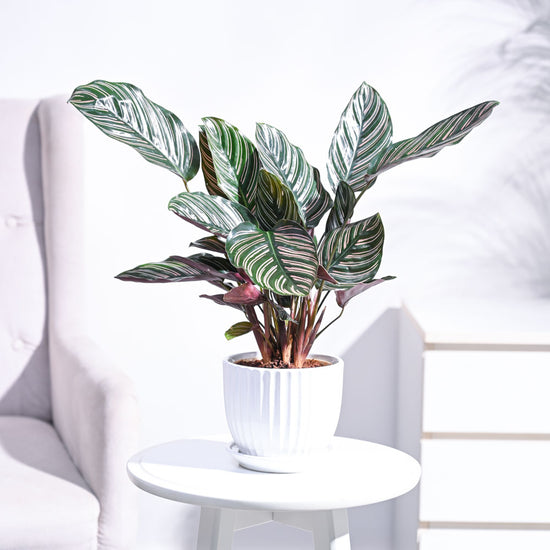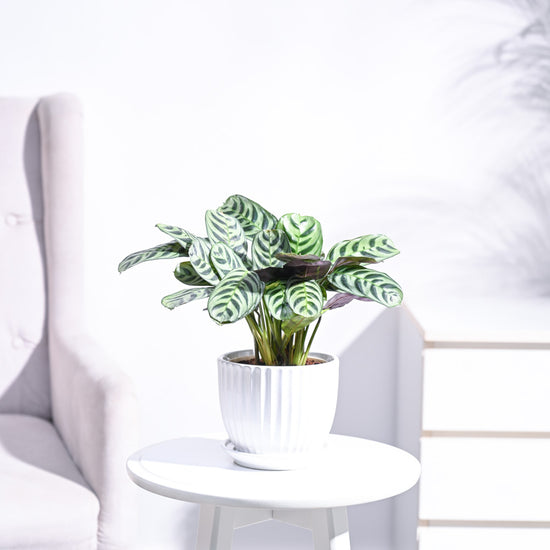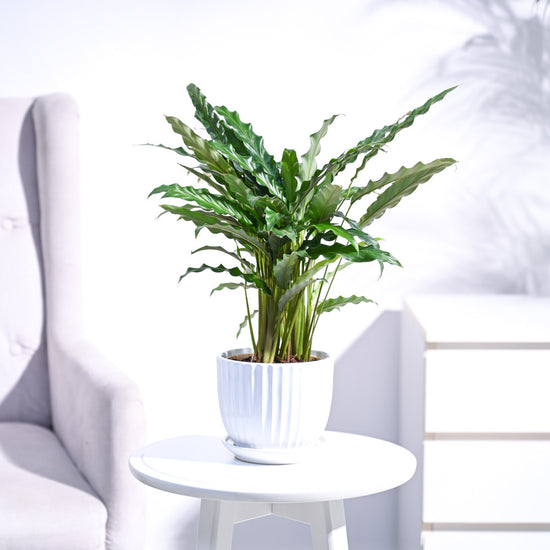●Buy Calathea Plants Online: Bring That Tropical Charm Indoors!
Relatively easy to care for and absolutely stunning, Calathea plants have become beloved indoor plants. There are countless Calathea varieties to choose from, giving you a wide range of plants that will individually suit your many moods, aesthetics, and ever-changing preferences for plant decor. Their attractive foliage is just one thing that makes them desirable! Here’s everything to know about Calatheas!
●Some Common Features to Know About All Calathea Types
Here are a few things that Calathea houseplants are known and beloved for:
1. Vibrant Foliage
Calathea plants are known to have vibrant and unique foliage that sets them apart from the other plants. Their wonderful and memorable patterns give them an edge over other
indoor plants that we commonly buy!
2. Prayer Plants
The leaves of these
Calathea Prayer Plant are known well for their quality of ‘closing up’ at night. They close up and face upwards at night, giving the illusion that they are “prayer”, thus the name.
3. Low Light Lovers
A lot of Calathea plant varieties are known for their low light tolerance and some of them even prefer to be kept in low light conditions. Since a lot of them are variegated, they require low light to sustain and maintain their coloring.
●Calathea Plants Benefits: Why Keeping Them Indoors is Good
Calathea plants are more than just pretty faces. Here’s why Calathea plants are beneficial to keep indoors:
1. Air Purification
By filtering out commonly found toxins such as formaldehyde, benzene, and other particulate matter, Calathea plants establish themselves as great air purifiers. To complete their own processes, these plants absorb all this material and in turn, they give out oxygen, giving us a healthier and cleaner breathing space.
2. Promote Well-being
Caring for houseplants, in this case Calathea houseplants, has been proven to be therapeutic. It reduces stress and improves mood drastically, leaving us with a feeling of satisfaction and joy. Additionally, the act of tending to plants and actually watching them grow is rewarding like nothing else!
3. Humidity Regulation
Calathea plants naturally release moisture through a process called transpiration, which can help maintain indoor humidity levels. This is particularly beneficial in dry environments or during winter when indoor heating can reduce air moisture.
4. Noise Reduction
The broad leaves of all kinds of Calathea plants can help absorb sound, reducing ambient noise levels in indoor spaces. This makes them a good choice for busy households or workspaces.
5. Non-Toxic to Pets
Calathea plants are also beloved in pet households for their pet-friendly nature. They are not toxic to pets if accidentally ingested, especially if you’ve got curious cats who just can’t keep calm!
●Calathea Types: Varieties to Choose From
There are countless kinds of Calatheas to choose from, giving you a wide range of options depending on your mood, preferences, and existing decor. Here are a few of them:
1. Calathea Sanderiana
Calathea sanderiana, also known as Pinstripe Calathea, features dark green leaves with striking pink pinstripes and a purple underside. For optimal care, place in indirect light, maintain high humidity, and keep the soil consistently moist with filtered water. Avoid direct sunlight and cold drafts.
2. Calathea Orbifolia
This
Calathea Orbifolia plant boasts large, round leaves with silver and green striped patterns. This grows best in bright, indirect light and can even tolerate low light conditions, high humidity, and keep the soil evenly moist using filtered water. Regularly clean the leaves to maintain their vibrant appearance.
3. Calathea RattleSnake Plant
Also called
Calathea lancifolia, this Calathea houseplant features long, lance-shaped leaves with wavy edges, dark green spots, and a purple underside. Care includes understanding that it can thrive in low light areas as well as indirect light, high humidity, and consistently moist soil. Avoid direct sunlight and waterlogging.
4. Calathea Network
The
Calathea Network plant, known for its intricate, web-like leaf patterns in shades of green, is a striking houseplant. For optimal care, provide bright, indirect light, high humidity, and consistently moist soil using filtered water.
●Calathea Plants Care Tips to Follow
While relatively low maintenance, the Calathea plants still require some of their basic needs met in order to thrive within their direct environments. So, here are a few Calathea care tips to follow:
1. Light Requirements
Calatheas usually require bright, indirect light but a lot of them also love low light environments. Some of the variegated ones, like Calathea Sanderiana, prefer lesser light and retain their coloring better in such conditions.
2. Watering
Water your Calathea plants twice a week and ensure that the soil in their pots is consistently moist but not waterlogged. Tropical plants like these require moist soil but hate wet feet. So, water when the soil is partially dried out and ensure the usage of a pot with adequate drainage holes. This allows the excess water to drain away every time you water your plant.
3. Humidity
As tropical plants, all Calathea types typically appreciate higher humidity levels. Regular misting or placing a humidifier nearby can help create a more favorable environment, especially for
indoor palm plants. If you cannot do either, choose to place a tray of water, lined with pebbles, near the plant. This will allow the water to evaporate and reach the leaves when they need it.
4. Soil
Like most other indoor plants, Calathea plants need well-drained and well-aerated soil. They cannot stand the suffocation of waterlogging or wet feet, meaning you must use soil that lets out excess water instead of retaining it. For this, you can use a mixture of our
Potting soil,
Perlite for better drainage, and
Cow Manure for fertilization.
5. Calathea Fertilizer
Every four weeks during the growing season - i.e. once every month - fertilize your Calathea houseplants with a liquid fertilizer diluted to half-strength with water. If you’re unable to find a balance between your fertilization schedules, then you can also make use of Ugaoo’s Plant
Food Fertilizer Sticks to ensure a proper and continuous supply of nutrients to your plants. The sticks release nutrients into the soil every time you water your potted plants, meaning you don’t have to put in too much time or effort! One of the best fertilizers for Calathea plants will be something that gives it a consistent, continuous, and slow supply for nutrients.
 Calathea Sanderiana
Calathea Sanderiana Calathea Orbifolia - Medium
Calathea Orbifolia - Medium Calathea Rattlesnake Plant
Calathea Rattlesnake Plant Calathea Freddie - Medium
Calathea Freddie - Medium Calathea Burle Marxii Plant
Calathea Burle Marxii Plant Calathea Rufibarba Plant
Calathea Rufibarba Plant










